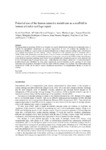Mostrar o rexistro simple do ítem
Potential use of the human amniotic membrane as a scaffold in human articular cartilage repair
| dc.contributor.author | Díaz-Prado, Silvia | |
| dc.contributor.author | Rendal Vázquez, María Esther | |
| dc.contributor.author | Muiños-López, Emma | |
| dc.contributor.author | Hermida Gómez, Tamara | |
| dc.contributor.author | Rodríguez-Cabarcos, Margarita | |
| dc.contributor.author | Fuentes Boquete, Isaac Manuel | |
| dc.contributor.author | De-Toro, Javier | |
| dc.contributor.author | Blanco García, Francisco J | |
| dc.date.accessioned | 2015-06-16T11:46:48Z | |
| dc.date.available | 2015-06-16T11:46:48Z | |
| dc.date.issued | 2010-04-13 | |
| dc.identifier.citation | Díaz-Prado S, Rendal-Vázquez ME, Muíños-López E, Hermida-Gómez T, Rodríguez-Cabarcos M, Fuentes-Boquete I, et al. Potential use of the human amniotic membrane as a scaffold in human articular cartilage repair. Cell Tissue Bank. 2010;11:183-195. | es_ES |
| dc.identifier.uri | http://hdl.handle.net/2183/14686 | |
| dc.description.abstract | [Abstract] The human amniotic membrane (HAM) is an abundant and readily obtained tissue that may be an important source of scaffold for transplanted chondrocytes in cartilage regeneration in vivo. To evaluate the potential use of cryopreserved HAMs as a support system for human chondrocytes in human articular cartilage repair. Chondrocytes were isolated from human articular cartilage, cultured and grown on the chorionic basement membrane side of HAMs. HAMs with chondrocytes were then used in 44 in vitro human osteoarthritis cartilage repair trials. Repair was evaluated at 4, 8 and 16 weeks by histological analysis. Chondrocytes cultured on the HAM revealed that cells grew on the chorionic basement membrane layer, but not on the epithelial side. Chondrocytes grown on the chorionic side of the HAM express type II collagen but not type I, indicating that after being in culture for 3–4 weeks they had not de-differentiated into fibroblasts. In vitro repair experiments showed formation on OA cartilage of new tissue expressing type II collagen. Integration of the new tissue with OA cartilage was excellent. The results indicate that cryopreserved HAMs can be used to support chondrocyte proliferation for transplantation therapy to repair OA cartilage. | es_ES |
| dc.description.sponsorship | This study was supported by grants: Servizo Galego de Saúde, Xunta de Galicia (PS07/84), Catedra Bioiberica de la Universidade da Coruña and Instituto de Salud Carlos III CIBER BBN CB06-01-0040. Silvia Diaz-Prado is beneficiary of an Isidro Parga Pondal contract from Xunta de Galicia, A Coruna, Spain. Tamara Hermida-Gómez is beneficiary of a contract from Fondo de Investigación Sanitaria (2008), Spain. Emma Muíños-López is supported by Rheumatology Spanish Foundation, Spain. We would like to thank MJ Sánchez and P Filgueira for technical assistance. | es_ES |
| dc.description.sponsorship | Instituto de Salud Carlos III; CB06-01-0040 | |
| dc.description.sponsorship | Xunta de Galicia; PS07/84 | |
| dc.language.iso | eng | es_ES |
| dc.publisher | Springer | es_ES |
| dc.relation.uri | http://dx.doi.org/10.1007/s10561-009-9144-1 | es_ES |
| dc.rights | The final publication is avaliable at link.spinger.com | es_ES |
| dc.subject | Amniotic membrane | es_ES |
| dc.subject | Chondrocytes | es_ES |
| dc.subject | Cartilage | es_ES |
| dc.subject | Osteoarthritis | es_ES |
| dc.subject | Cell therapy | es_ES |
| dc.title | Potential use of the human amniotic membrane as a scaffold in human articular cartilage repair | es_ES |
| dc.type | info:eu-repo/semantics/article | es_ES |
| dc.rights.access | info:eu-repo/semantics/openAccess | es_ES |
Ficheiros no ítem
Este ítem aparece na(s) seguinte(s) colección(s)
-
GI-TCMR - Artigos [123]
-
INIBIC-TCMR - Artigos [102]
-
INIBIC- REUMA - Artigos [183]






